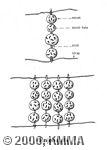
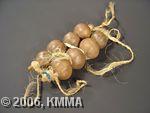
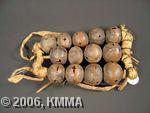
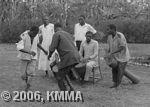
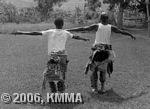
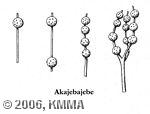
Other names: orunyegye, enyege, obunyegye, obuyebe, enzebazebe.
The enjebajebe and the akajebajebe are two rattles made from seed pods; the seed pods of the enjebajebe are tied together around the performer's leg to form a leg rattle, whereas the akajebajebe is a hand-held rattle consisting of one or several seed pods fixed to a stick.
The seed pods are from the oncoba routhledgei. The top and bottom are pierced with the sharp point of a knife and the fruits are then boiled. This softens the seeds and allows them to be easily removed. Once the seed pods are dried out again, they are fixed to a stick measuring 20 to 30 cm in length. Small moon-shaped holes are burnt into the seed pod with a knife or a heated point. The seed pod is then filled with a varying number of seeds (10 to 50) from the canna. The seed pods also differ in size; this produces a varied sound.
The enjebajebe, the leg rattle, consists of three to six seed pods fixed to one stick in such a way that they do not touch each other. A small groove is made into the ends of the stick and a cord - of plant fibre or animal sinew - is threaded along it. The rattle is then tied to the dancer's leg. The stick holding the seed pods is positioned at the back of the leg, on the dancer's calf. In the past just one single row of seed pods was always used but nowadays several rows are put next to each other, all tied to the same cord. Among the Tagwenda they use as many as seven rows.
The enjebajebe are worn by both men and women as they dance. The different-sized seed pods and the different number of seeds inserted produce a varied timbre. The instrument is never played solo but is always combined with percussion, rattles and/or the flute. The enjebajebe is mostly used in the traditional dances of the Iru, Tagwenda, Hororo, Kunta and the Kiga, but they are also indispensable in the entogoro, a dance of the Kooki. Among the Hima they are also worn during eulogic recitations, when the speaker stamps his foot to the rhythm of his text.
The akajebajebe is a hand-held rattle that has two functions: it is used to play the egobore music bow and it is used in ritual music.
There are different types of hand-held rattle and the number of seed pods can vary from 1 to 10. Among the Kiga and the Hutu, akajebajebe with one seed pod are used, but the Nyambo fix a seed pod to both ends of the stick. These types of akajebajebe are used together with the egobore. The Kiga also use the akajebajebe in their rituals, but in this case the instrument is made up of several seed pods, either one stick with three to five seed pods or a forked stick with as many as ten seed pods. The latter is used by the medicine-men and witch-doctors.
for more information see also: VAN THIEL, Paul, "Multi-Tribal Music of Ankole. An ethnomusicological study including a glossary of musical terms." Edited by the Royal Museum for Central Africa, Annales, Sciences Humaines, nr 91, 1977, 234 pp.
© KMMA/Paul VAN THIEL